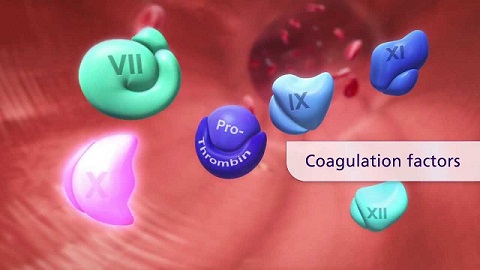
- Blood clotting factors or coagulation factors are the most essential components of hemostasis.
- Hemostasis is a process that results in the formation of a blood clot and prevents excessive bleeding and retains blood in response to any vascular endothelial injury.
- Various clotting factors are involved in the coagulation cascade which are mainly divided into two types;
- Plasma coagulation factors
- Platelets coagulation factors
- These coagulation factors help in blood clotting through different pathways.
A. Plasma coagulation factors:
- These are the coagulation factors present in blood plasma.
- There are thirteen plasma coagulation factors which are recognized and identified by Roman numerals I to XIII.
1. Factor I: Fibrinogen:
- Origin: It is a plasma protein synthesized in liver.
- Function: It is a precursor of Fibrin. Fibrinogen is converted into fibrin in the final stage of blood clotting.
2. Factor II: Prothrombin:
- Origin: It is a plasma protein synthesized in liver which requires Vitamin K for synthesis.
- Function: It is a precursor of an enzyme Thrombin. Fibrinogen is converted into fibrin by Thrombin.
3. Factor III: Thromboplastin:
- Origin: It is a complex lipoprotein formed from disintegrating platelets or tissues.
- Function: It combines with calcium to convert prothrombin into active thrombin.
4. Factor IV: Calcium ions:
- Origin: They are inorganic ions present in plasma but acquired from bones and diet.
- Function: They are necessary for formation of thrombin and for all stages of blood clotting.
5. Factor V: Proaccelerin:
- It is also known as labile factor or accelerator globulin.
- Origin: It is a plasma protein synthesized in liver.
- Function: It is necessary for extrinsic and intrinsic pathways.
6. Factor VI:
- It is no longer thought to be a separate entity.
- It possibly has same origin and function as factor V.
7. Factor VII: Serum prothrombin conversion accelerator (SPCA)
- It is also known as stable factor or proconvertin.
- Origin: It is a plasma protein synthesized in liver which requires Vitamin K for synthesis.
- Function: It is necessary for the first phase of extrinsic pathway.
8. Factor VIII: Anti-hemophilic factor (AHF)
- It is also known as anti-hemophilic factor A (AHF-A) or anti-hemolytic globulin (AHG).
- Origin: It is a plasma protein (globulin) which is synthesized in liver and other tissues.
- Function: It is necessary for the first phase of intrinsic pathway. Deficiency of AHF causes a genetic disorder.
9. Factor IX: Plasma thromboplastin component (PTC)
- It is also known as Christmas factor or anti-hemophilic factor B.
- Origin: It is a plasma protein synthesized in liver which requires Vitamin K for synthesis.
- Function: It is necessary for the first phase of intrinsic pathway. Deficiency of PTC causes hemophilia B.
10. Factor X: Stuart-Prower factor or Stuart factor
- Origin: It is a plasma protein synthesized in liver which requires Vitamin K for synthesis.
- Function: It is necessary for early phases of both extrinsic and intrinsic pathways.
11. Factor XI: Plasma thromboplastin antecendent (PTA)
- It is also known as anti-hemophilic factor C (AHC).
- Origin: It is a plasma protein synthesized in liver.
- Function: It is necessary for the first phase of intrinsic pathway. Deficiency of PTA causes hemophilia C.
12. Factor XII: Hageman factor or glass factor
- Origin: It is a plasma protein but the source is unknown.
- Function:
- It is necessary for the first phase of intrinsic pathway. It activates plasmin.
- It is activated by contact with glass, probably involved with the clotting of blood outside body.
13. Factor XIII: Fibrin-stabilizing factor (FSF)
- It is also known as Laki-Lorand factor.
- Origin: It is a protein present in plasma and platelets but the source is unknown.
- Function: It is necessary for the final phase of clotting.
B. Platelet coagulation factors:
- These are the coagulation factors present in platelets.
- There are four platelet coagulation factors which are identified as Pf1 to Pf4.
1. Platelet factor 1 (Pf1)
- It is also known as platelet accelerator.
- Origin: It is present in platelets.
- Function: It is same as plasma coagulation factor V and accelerates the action of platelets.
2. Platelet factor 2 (Pf2)
- It is also known as thrombin accelerator.
- Origin: It is present in platelets and phospholipids.
- Function:
- It accelerates thrombin formation at the start of intrinsic pathway.
- It also accelerates the conversion of fibrinogen into fibrin.
3. Platelet factor 3 (Pf3)
- It is also known as platelet thromboplastic factor.
- Origin: It is present in platelets and phospholipids.
- Function: It is necessary for the first phase of intrinsic pathway.
4. Platelet factor 4 (Pf4)
- Origin: It is present in platelets.
- Function: It binds the anticoagulant heparin during blood clotting.